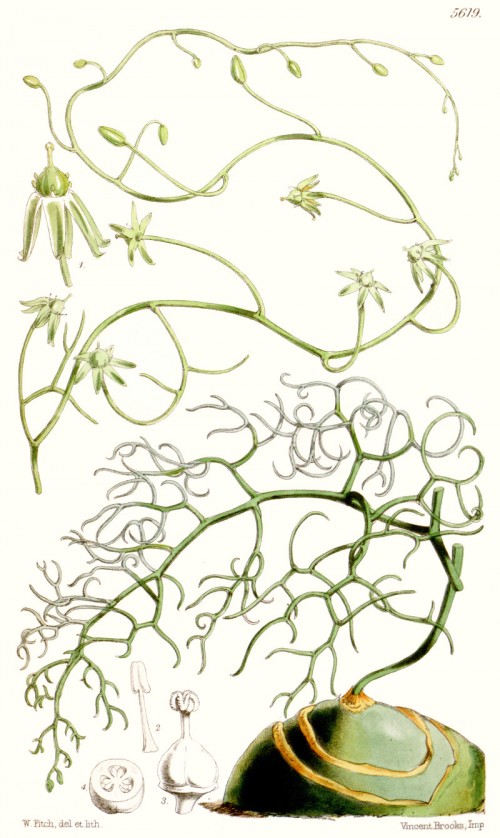Bowiea volubilis Harv. ex Hook. f. - syn.Schizobasopsis volubilis (Harv. ex Hook.f.) Macbr.; Ophiobostryx volubilis (Harv. ex Hook. f.) Skeels - Asparagaceae (also placed in Liliaceae, Hyacinthaceae)
knolklimop (afr.); climbing onion, Zulu potato, Kletterzwiebel, Zulukartoffel
Perennial bulbous herb, up to 3m long, native to East Africa, South Africa (Kenya to South Africa); bulbs near or at the soil surface, green, up to 15cm in diam.; stems leafless, scrambling or twining; leaves very few, basal, filiform, soon falling; flowers 16-24mm in diam., yellowish green, capsule c. 2.5cm long, brownish.
http://www.zimbabweflora.co.zw/speciesdata/species.php?species_id=114160
http://plantzafrica.com/plantab/bowieavolubilis.htm
„Reported to be cardiotonic, poison, purgative, the climbing onion is a folk remedy for constipation, dropsy, and infertility.“
[CRC Handbook of Medicinal Herbs, 1985, p.82]
The bulbs contain bufadienolide glycosides, which act like cardiac glycosides of Digitalis purpurea. Bovosid A is thought to act like k-strophantin. Small portions of roasted bulbs are used as laxative, the juice of fresh bulbs is used in to treat ailments of the skin, dropsy and feminine sterility in folk medicine of South Africa.
[Hagers Handbuch der Pharmazeutischen Praxis, Springer 2010]
„In traditional medicine, B.volubilis ranks amongst the top 14% of the most traded medicinal plants in South Africa (Mander, 1998). The bulbs contain several active cardiac glycosides such as bovogenin A [aglycone, trans-fused A/B rings] and the structurally related bufadienolides… B.volubilis bulbs are used in the treatment of various ailments in traditional medicine. For instance, the bulbs are made into an infusion and given to pregnant women to assist in delivery (Hutchings et al., 1996). The crushed bulbs are used to massage the skin to prevent infections and can be prepared as a lotion for vsore eyes (Van Wyk et al., 2009). A hot mixture of the outer bulb scales and water is used in the treatment of dropsy (Watt and Breyer-Brandwijk, 1962). Furthermore, Zulu herbalists prescribe the bulb for ascites, sterility, cystitis, backache, muscular pain and bladder infections (Van Wyk et al., 1997)… cultivated B.volubilis can be used in traditional medicine rather than relying on bulbs from wild populations.“
[A comparison of the pharmacological properties of garden cultivated and muthi market-sold Bowiea volubilis., Masondo, N.A., Ndhlala, A.R., Aremu, A.O., Van Staden, J., Finnie, J.F., South African Journal of Botany, 86, 2013, 135-138]
„The destructive harvesting of bulbs has led to a continuous decimation of wild populations. Consequently, there are increasing conservational concerns on the sustainability of this species for continuous supply to meet escalating demands…. Bowiea volubilis remains a widely used medicinal plant and available but limited scientific evidence indicates its anti-inflammatory potential. The abundance of cardiac glycosides in its phytochemical composition provides an indication on the therapeutic potential.“
[Aremu, A. O., Moyo, M., Amoo, S. O., & Van Staden, J. (2015). Ethnobotany, therapeutic value, phytochemistry and conservation status of Bowiea volubilis: A widely used bulbous plant in southern Africa. Journal of ethnopharmacology, JEPD1500978.]

Curtis’s Botanical Magazine, vol.93, ser.3, vol.23, t.5619 (1867) [W.H.Fitch]
http://plantgenera.org/species.php?id_species=153090
